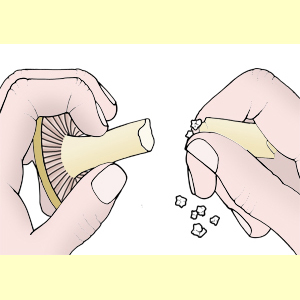
Stipe consistency is determined by attempting to bend the stipe, and also by attempting to crumble the stipe into pieces, as if crumbling dried bread. This feature must be determined on fresh material that is not overmature or waterlogged.
Choose this state if: the stipe is chalky in consistency. A chalky stipe is usually relatively thick stipe (diameter greater than 5 mm, and often more than 10 mm) and it snaps when broken in two. The surfaces exposed by the break are not fibrous. In addition, the stipe tissue crumbles readily into small pieces (as would dried bread), rather than breaking into long strips (as would a piece of celery) or being resistant to crumbling. A chalky stipe is usually solid or stuffed, and rarely hollow.
A chalky stipe is found only in species of Lactarius and Russula, and is due to the peculiar microscopic construction of the stipe context, which is made up of round elements (sphaerocytes) rather than longitudinal hyphae. Latex is often present when the stipe is chalky.
